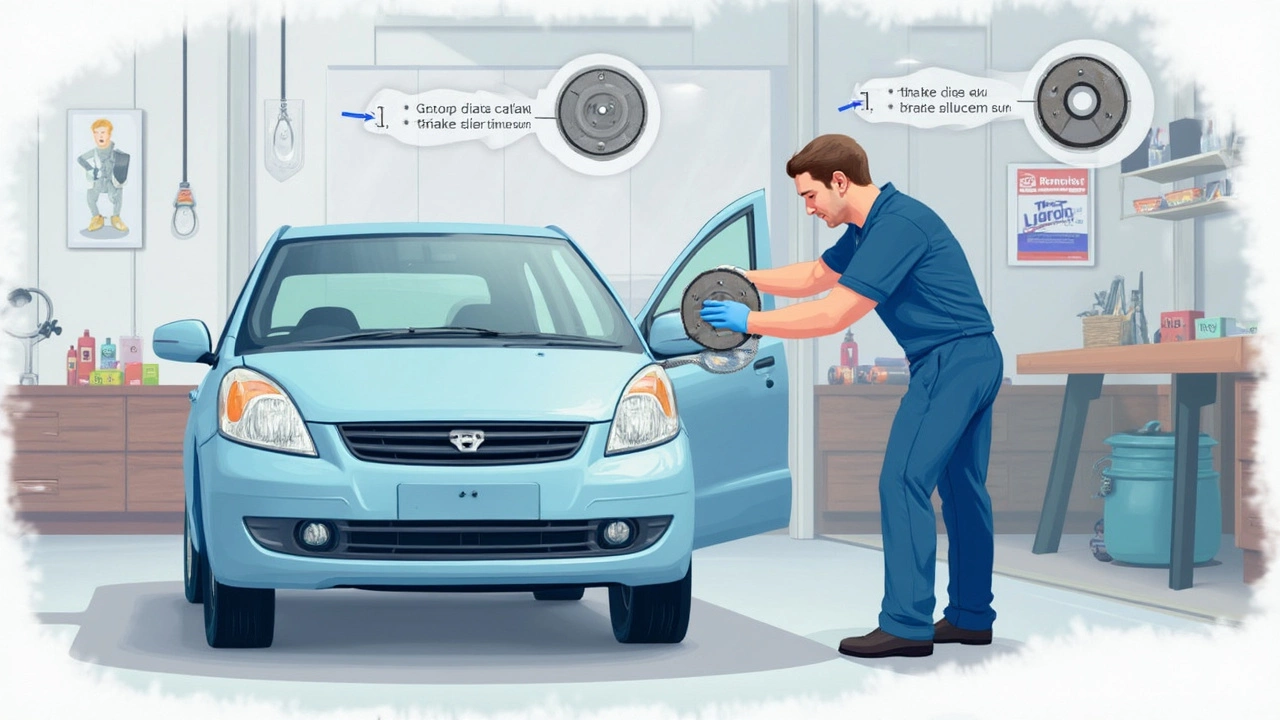Changing brake pads on their own is something a lot of folks consider to save time and money. If you’ve ever had a brake job quoted and felt your wallet cringe, you know where I'm coming from. But can you really just swap out the pads and leave the discs as they are? The answer isn't as simple as it seems, and it's worth understanding the finer details.
First off, think about what brake pads and discs are doing when you're driving. The pads are the bits that actually press against the discs to slow your car down. Over time, the pads wear down, which is perfectly normal. So, it's usual to change them more often than the discs.
- Why Change Just the Brake Pads?
- When Discs Also Need Attention
- Lifespan of Brake Components
- Signs Your Discs Are Worn
- Tips for DIY Brake Maintenance
- Professional Advice and Costs
Why Change Just the Brake Pads?
For many car owners, the idea of swapping out just the brake pads and not the discs comes down to one simple objective: cost savings. New brake pads are significantly cheaper than getting both the pads and discs replaced. So, if your discs are still in good shape, why not?
Think of brake pads like the shoes on your feet—they wear out with all that walking, or in this case, stopping. You're destined to replace them more often. But the discs, akin to the tough soles of boots, don't get as worn as quickly, depending on your driving habits.
Changing only the pads could be a good call under certain conditions. If you notice the wear indicator on your pads is activated, yet the discs show no signs of damage or wear, you're in the clear to just handle the pads for now. The trick here is to keep an eye out for any deep grooves or cracks on the discs, as those are sure signs you need to replace the discs too.
Another reason for sticking just to the pads could be driving style. If you're a cautious driver who avoids hard braking, your discs might last longer since you’re gentle on them. Conversely, if you're often driving in stop-and-go traffic, the brake pads will wear faster, and you'll end up changing them more frequently.
Here's a quick check you can do at home: look through your wheel spokes to see the surface of the disc. If it's smooth, not warped, and roughly the thickness indicated in your car's manual, you may not need to fuss with the discs yet.
When Discs Also Need Attention
Alright, here's the scoop: while it’s tempting to just change the brake pads and call it a day, sometimes those brake discs need love too. If your discs are showing signs of wear, ignoring them could lead to trouble down the road—literally.
Discs wear out for a few reasons. One biggie is heat. Every time you hit the brakes, the friction generates heat, which over time can warp or crack the discs. You might not notice it at first, but listen closely. If you hear a squealing or grinding sound, or if your steering wheel shakes when you brake, these are red flags. This could mean your discs need a closer look or replacement.
The thickness of the discs matters too. Car manufacturers set a minimum thickness for safety reasons. If the disc is too thin, it can affect stopping power. Usually, your car manual or a quick search can help you find these specs. It’s crucial not to let the discs get too worn down, or else swapping out your pads might not be enough to keep everything running smoothly.
Another thing to keep an eye on is uneven wear. If your discs have worn unevenly, it won’t matter how new your pads are—they won’t grip right. This can sometimes happen if the discs heat and cool unevenly.
| Sign | What It Means |
|---|---|
| Squealing noise | Possible disc wear |
| Vibration while braking | Warped disc |
| Visible grooves on the disc | Excessive wear |
If you’re not sure whether your discs need attention, a quick inspection or a visit to a mechanic can be a lifesaver—not to mention, keep you from a hair-raising commute. It's always better to nip these issues in the bud rather than wait until they become a bigger problem.
Lifespan of Brake Components
The lifespan of brake pads and discs can be a bit all over the place, depending on how you drive and the conditions you face daily. Brake pads usually last between 30,000 to 70,000 miles. If you're mostly cruising on highways without much stopping, you're likely to hit the upper end of that range. But if you're often stuck in stop-and-go traffic or live in a hilly area, your pads might wear out faster.
When it comes to brake discs, they typically enjoy a longer lifespan of around 70,000 to 100,000 miles. However, this isn't set in stone. Rough driving or extreme conditions can eat up the discs just as quickly as they do the pads. Regular checks are key to ensuring they're in good shape.
Here's a helpful tip: keep an eye or ear out for strange sounds. Screeching, grinding, or anything out of the norm could mean it's time to take a peek at your brakes. It’s also a smart idea to check the thickness of your brake pads regularly. If they're under 3 millimeters thick, it's time for a replacement session.
If you like seeing things in numbers, here’s a rough idea in a visual format:
| Component | Lifespan (miles) |
|---|---|
| Brake Pads | 30,000 - 70,000 |
| Brake Discs | 70,000 - 100,000 |
Remember, doing a quick visual check during your routine oil change or tire rotation can save you from bigger headaches on the road. Keep your brake pads and discs in check, and you'll be ensuring not just your safety, but also that of others traveling the same roads.

Signs Your Discs Are Worn
Alright, you're thinking of just changing those brake pads, but how do you know if the brake discs need attention too? Ignoring worn discs can lead to less effective braking, and that’s definitely not what you want.
One major sign is if you feel a vibration or pulsation when you press the brake pedal. This often happens when the discs are warped. It's not just annoying—it can be dangerous, so keep an eye (or foot) out for it.
Noisy brakes are another red flag. If you hear a screeching or grinding sound, it’s possible your discs are worn out. Squealing usually means the pads are worn, but grinding can indicate more severe issues with your discs.
Take a peek at the discs themselves, if you can. Visible grooves or deep scores in the discs aren't good news. They should be relatively smooth, so any rough parts mean they’re not in the best shape.
Sometimes the car just doesn’t stop as quickly as it used to, yet everything else seems normal. This can be a subtle hint that your discs are nearing the end of their life. Or if you notice your braking distance is longer than usual, it's time to consider an inspection.
- Vibration when braking
- Squeaking or grinding noises
- Visible grooves or scores on the discs
- Reduced braking efficiency
Keeping an eye out for these signs might just save you from a nasty surprise down the road, and knowing when to replace not just the pads but the discs too will keep your ride smooth and safe.
Sometimes it helps to know the technical details too. Here’s a quick look at some typical brake disc metrics:
| Disc Diameter | Disc Thickness |
|---|---|
| 240-330 mm | 22-28 mm |
If you have the tools, measure these yourself or ask a pro to check. If the discs aren't within the recommended thickness, it's a good idea to replace them.
Tips for DIY Brake Maintenance
If you're thinking of handling the job yourself, changing brake pads can be a great way to understand your car better and save a few bucks. However, it's essential to go about it the right way to avoid any mishaps later down the road. Here are some practical tips to steer you in the right direction.
First, gather all the necessary tools. You don't want to get halfway through the job only to realize you're missing something crucial. Here's a basic list of what you'll need:
- Jack and jack stands
- Lug wrench
- C-clamp (for compressing the brake caliper)
- Open-end or adjustable wrench
- Brake fluid (just in case)
- New brake pads
Once you've got everything ready, make sure your car is on a level surface and securely jack it up before you remove the wheels. Safety first!
Next, it's crucial to inspect the brake discs, even if you're only changing the pads. Look out for any deep grooves, cracks, or discoloration. If you spot anything unusual, it might be time to replace the brake discs too.
When installing new pads, clean everything thoroughly. Dirt and grime can affect performance, so a good cleaning spray can help make sure everything goes on smoothly. Once you've fit the new pads, reassemble everything in reverse order.
After everything is back in place, pump the brake pedal a few times before driving to ensure everything is seated correctly. If the pedal feels spongy, you might need to bleed the brakes to remove any air from the system.
Here's a quick example of how often these parts might need changes, based on average usage:
| Part | Average Lifespan |
|---|---|
| Brake Pads | 30,000 to 70,000 miles |
| Brake Discs | 70,000 to 100,000 miles |
It's always a good idea to read up and even watch a video or two before starting, especially if it's your first time. With a bit of care and attention to detail, you'll have those brakes in top shape in no time!
Professional Advice and Costs
Alright, so you might wonder when it's time to call in a pro to look at your brake pads and discs. If you're not sure whether the noise your car's making is normal, or you're just not 100% confident in diagnosing the health of your brake discs, it's wise to get some expert eyes on it. Mechanics can check the thickness of the discs and see if there's any warping or scores that aren't safe.
As a rule of thumb, if the discs are below the minimum thickness specified by your car's manufacturer, you should definitely change them. A thin disc can affect braking performance and isn't something you want to take lightly.
"Brake service isn't just about swapping parts; it's about ensuring the overall safety of your vehicle," says Tom Gallagher, a seasoned mechanic at AutoCare Central.
When it comes to costs, changing just the brake pads can be a lot cheaper than doing pads and discs together. On average, brake pad replacement might set you back around $100 to $300 per axle, depending on the type and brand. But throw in new discs, and you're looking at $300 to $800 for both pads and discs per axle. Prices vary based on the car make and model, and whether you're opting for parts from the original equipment manufacturer (OEM) or aftermarket options.
- OEM parts generally guarantee a perfect fit and are tested rigorously, but they can cost more.
- Aftermarket parts provide a range of options and prices, often appealing if you're on a budget.
Whatever route you choose, remember that proper maintenance can help extend the life of both parts, saving you money in the long run. Even if you're a whiz with tools, regular inspections by a pro can catch issues you might miss.

